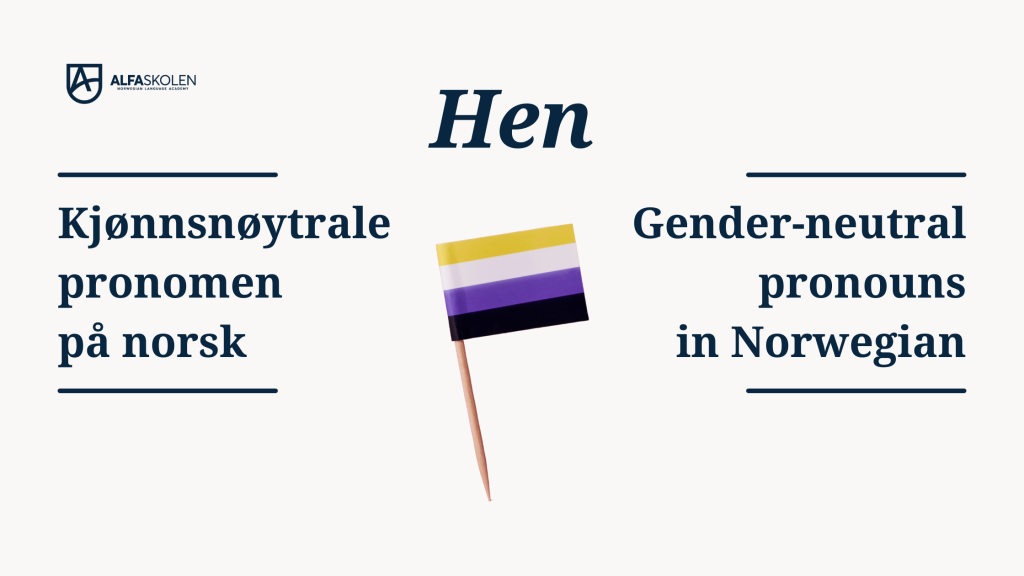‘Hen’: Gender-Neutral Pronouns in Norwegian

Have you seen or heard people using the pronoun «hen» and are wondering what it means? Do you need a gender-neutral pronoun so you can write more inclusive texts in Norwegian, or because you know someone who is nonbinary? Read on and find out everything you need to know about «hen» and why it’s important!
Hen as a personal pronoun
Hen is a pronoun we can use in Norwegian when we want to refer to a single person without specifying their gender, much as we use singular they/them in English. As in English, we can also use hen to refer to specific people who prefer that pronoun instead of han or hun — these are often people who identify as nonbinary. The pronoun hen was approved in both of these meanings by Språkrådet, the Norwegian Language Council, in 2022.

Other gender-neutral solutions in Norwegian
All languages need a way to express that a person’s gender is unknown or irrelevant, and Norwegian is no exception. Here are some alternatives to hen:
Han
En person skal være stolt av det han gjør (A person should be proud of what he does)
It is still possible to use the masculine pronoun in Norwegian in a generic way, but this solution is not used much anymore and feels quite old-fashioned, as in English.
Vedkommende
En person skal være stolt av det vedkommende gjør (A person should be proud of what that person does)
Vedkommende is a word that means something like the effected person or the relevant person, and is a way to avoid using pronouns altogether. For me, this solution feels somewhat impersonal and long, but it remains a popular way to avoid specifying gender, especially in more formal situations.
«Han eller hun» or «hun eller han»
En person skal være stolt av det hun eller han gjør (A person should be proud of what she/he does)
Han eller hun (evt. hun eller han) is also much-used, but can feel unwieldy and suggests that nonbinary people are not included. This is Norwegian’s he/she or she/he.
Plural
Folk skal være stolte av det de gjør (People should be proud of what they do)
It is often possible to avoid the whole situation by writing in the plural, since the plural pronoun de (they) is not gendered in Norwegian (or in English). This often works well, but it doesn’t always make sense. I will discuss the use of singular de/dem shortly.

Nonbinary pronouns in Norwegian
There are many ways to express that a person’s gender is unknown or irrelevant, but when it comes to specific people, it’s only okay to use the pronoun that they themselves prefer. This usually means han/(ham) (he/him) for men and hun/henne (she/her) for women. The most common pronouns for nonbinary people in Norway today are hen and de/dem, but there are also other pronouns in use, and some people feel comfortable with several pronouns (e.g. han/hen, hen/de). The only way to know is to ask!
Hen fits in relatively well in the Norwegian pronoun system, but it isn’t without its flaws. There are for example some Norwegian dialects which already pronounce the masculine pronoun (bokmål’s han) as hen, and the possessive form hens can sound too close to the feminine hennes for some people. For these and many other reasons, de/dem or other pronouns are also popular among Norwegian nonbinary people.
De/dem in the singular (either about a known, nonbinary person or an unknown, generic person) is, as far as I know, relatively new in Norwegian, in contrast to many centuries of singular-they in English.
The history of hen
The pronoun hen originally comes from the Finnish pronoun hän. Finnish, and many other languages, don’t distinguish between gender in the third person singular, so hän can refer to people of any gender. This pronoun, written hen, has a long history in Swedish, dating all the way back to 1966.
While hen is a loanword from Finnish, by way of Swedish, de/dem in singular is most likely a calque from English. This is a type of loanword where the elements are translated, instead of adopting the entire word wholecloth. Kindergarten was loaned directly from German to English, but in Norwegian it was loaned as a calque (Kinder (children/barn) + Garten (yard/hage) = barnehage). This is especially exciting because they is of course originally a loan from Old Norse (þeir)!
Hen has been used in Norwegian well before 2022, but that was the year in which it was officially recognized by Språkrådet.
Hen as an adverb
It is important to notice that hen isn’t always a pronoun! In expressions like hvor skal du hen? (where are you going?), the word is used as an adverb. It is very common in many languages to have words that mean different things but are written and pronounced the same, and context is almost always sufficient to tell them apart. Read more here.
«De/Dem» in second person: an old, polite form of address
In the same way that hen can be a pronoun or an adverb, it’s important to distinguish between de/dem in the third person (singular or plural) and De/Dem in second person (singular). We capitalize De/Dem when we want to address someone very politely, but this form is going out of style, and is used only in some specific cases today. Regardless, it is worth knowing that it exists, because you’ll see it around occasionally, for example in historical contexts or in reference to older people. . It is never wrong or impolite to use du/deg in modern Norwegian!

By using the pronoun “hen” correctly, you contribute to creating an inclusive and modern language. Do you want to learn more about Norwegian grammar and improve your language skills? Sign up for one of our Norwegian courses at Alfaskolen. We offer courses for all levels, from beginner to advanced, both online and in Oslo.
Written by Madsen Sparler (hen/de), Norwegian teacher at Alfaskolen.
Tags:


